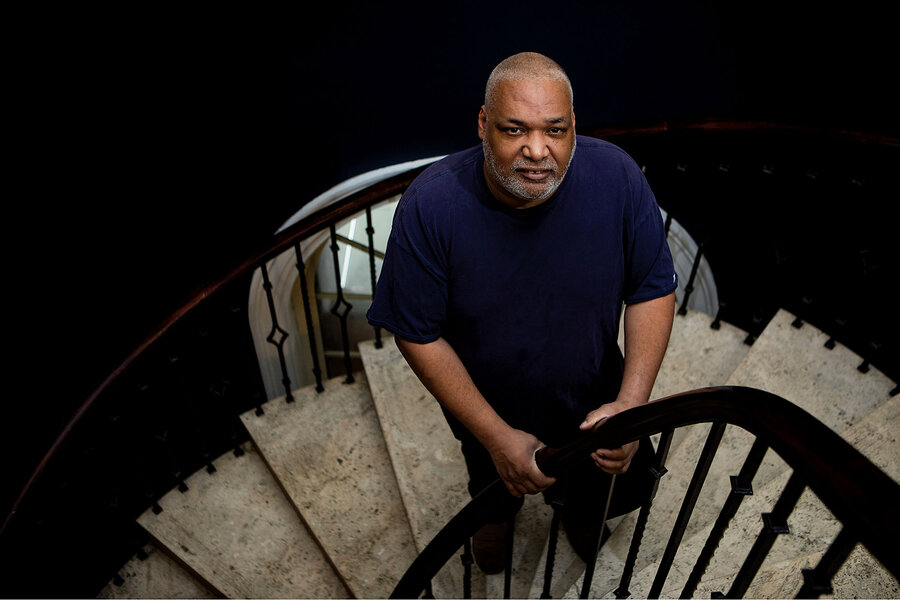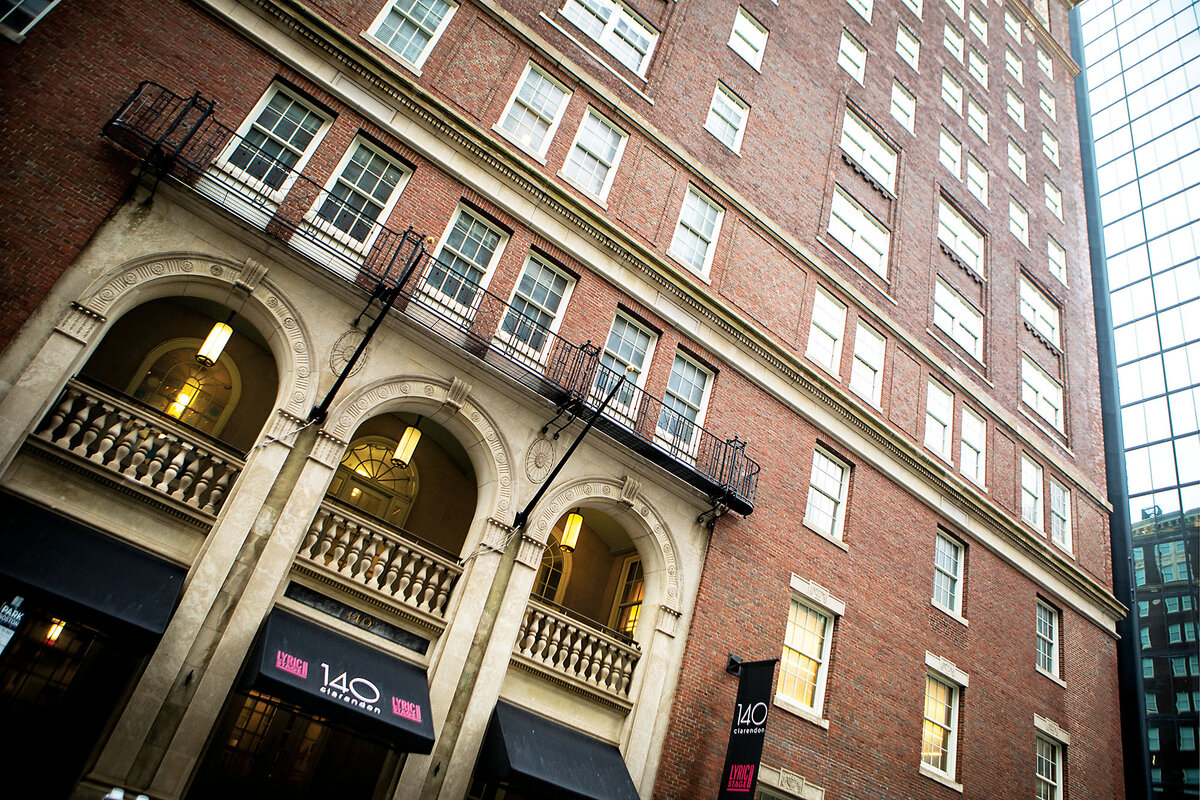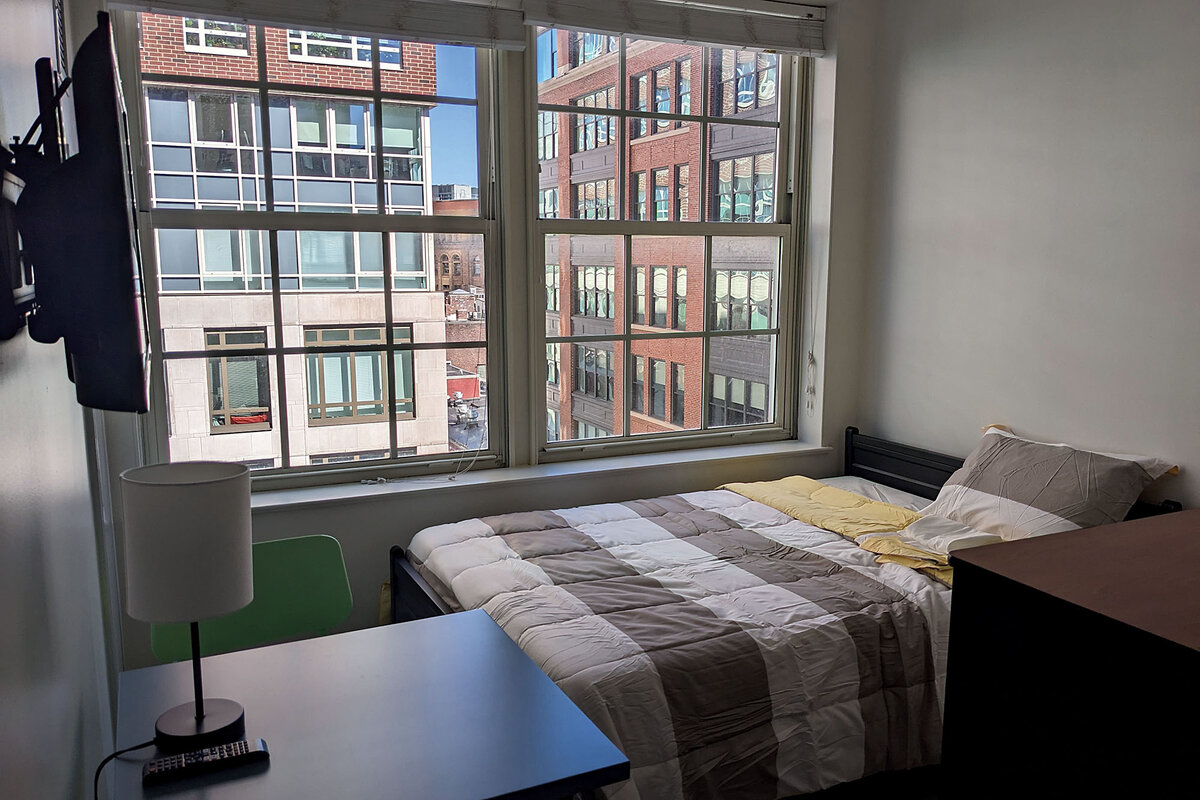Why Boston’s wealthy Back Bay said yes, in our backyard
Loading...
| Boston
Garry Monteiro pauses and looks down, twiddling his thumbs. He contemplates the biggest change to his life last year. There’s a glint in his eye that wasn’t there before.
“To be honest with you, the refrigerator was a big deal,” Mr. Monteiro chuckles, speaking in a community room at the 140 Clarendon building in Boston’s upscale Back Bay neighborhood. “I can get anything I want from the grocery store now that I have a refrigerator and my own cabinets.”
But, he adds, the biggest change is having somewhere to call his own. Before moving into his apartment, the former mail courier spent nearly every night for two years on an assigned bunk at a men’s shelter.
Why We Wrote This
A story focused onNIMBY can be a powerful force in wealthy areas. Here is what happens when neighbors say yes.
His routine was dictated by the shelter’s hours. He had to be out by 5:30 a.m. and back before 8 p.m. He spent his days looking for jobs or with his siblings. Every day, he worried about making it back by curfew. If he didn’t, he’d have to sleep outside.
In the shelter, his only place for privacy was the restroom. Now, Mr. Monteiro has his own studio with a bathroom, kitchenette, and of course, the refrigerator. “The solitude is priceless after sleeping in a room with 30 or 40 people,” he says. “Right now I have $4 sitting on my nightstand. I’ve come and gone all week, and it’s still there.”
The 140 Clarendon building is the rare story of a wealthy community finding solutions to homelessness. When private hotel plans stalled at the address in 2020, the neighborhood took charge. Community associations and developers backed a permanent supportive housing community – complete with on-site social services – in the heart of one of Boston’s most expensive neighborhoods.
“With homelessness numbers rising everywhere and the lack of affordable housing overwhelming, this project in the Back Bay is a welcome development,” says Howard Koh, faculty chair of the Initiative on Health and Homelessness at Harvard University. Dr. Koh and his team say that 140 Clarendon is “highly unusual,” because instead of worrying about property values, residents in a high-end neighborhood rolled out the welcome mat.
Dr. Koh calls it “a laudable development that offers leadership lessons for all cities.”
Permanent supportive housing communities often face opposition from residents. In Los Angeles County, renovation plans for an abandoned motel have become a battleground for homeowners concerned about property values, who say not in my backyard (NIMBY). In Austin, Texas, residents halted the development of a housing community over fears about traffic congestion.
“The collaboration of all the partners, public and private, to make such progress is a great example of how people can ... rise to the challenge,” Dr. Koh says of 140 Clarendon.
Housing-first solutions
The 111 studio apartments that now house Mr. Monteiro and his new neighbors also come with support services and case managers. The idea isn’t new, experts on “housing-first” solutions say. Studies have shown the most cost-effective way to combat homelessness is to prioritize putting people in homes before securing other services. Permanent supportive housing is found in almost any city, from the buildings operated by the Skid Row Housing Trust in Los Angeles to Cooper House in Fargo, North Dakota.
What’s remarkable about 140 Clarendon is that Back Bay’s neighborhood and business associations signed letters of support, inviting the project onto their streets. It’s the opposite of NIMBY – and an example of what can happen when wealthy neighborhoods say yes.
“It is one of those all-too-rare occasions when the public sector, the private sector, and nonprofits were able to come together and provide at least some relief,” says Martyn Roetter, chair of the Neighborhood Association of the Back Bay, who signed one of the letters.
In the United States, Boston is the third-most-expensive city for renters, according to January data from the rental platform Zumper. In 2020, Boston was ranked the third-most-gentrified city, according to a study by the National Community Reinvestment Coalition. As housing prices rise, shelters across the state say they are at or over capacity.
For nearly 100 years, 140 Clarendon has anchored the neighborhood’s educational and cultural character. The building was owned by the YWCA and, at various points, has housed the Lyric Stage Company of Boston, the Snowden International School, and a 210-unit boutique hotel.
In 2019, the YWCA decided to sell the property. The first buyer planned to evict all tenants and face-lift the exterior to make way for a ritzy private hotel. When the pandemic sank the hotel market, a new developer – Beacon Communities – stepped in, while Pine Street Inn agreed to provide on-site services to formerly houseless tenants. “It checked all our boxes, and the location couldn’t be better,” says Jan Griffin, vice president of Pine Street Inn. The 13-story brick-faced building has elevators and is easily accessible to public transit, grocery stores, the Boston Public Library, and churches.
Pine Street Inn has been a trailblazing nonprofit in combating chronic homelessness. Aside from having the largest overnight shelter in New England, the nonprofit owns and manages more than 440 permanent supportive housing locations for close to 900 men and women in Greater Boston.
“It’s the right thing to do”
The Back Bay neighborhood associations – which wanted to preserve the historic brownstone and its commercial tenants – had caught wind of the development plans. In two public letters of support, the associations advocated for affordable housing to be expedited in the neighborhood.
“We’re often accused of being NIMBYs, but we’re not an island to ourselves,” says Mr. Roetter. “It’s the right thing to do. And it’s also a vehicle through which we inform ourselves of what the problems really are.”
In addition to 111 apartments for people experiencing homelessness, 99 other units were made into affordable housing. All the commercial tenants supported the plan, which allowed them to remain in the building. “The fact that the local businesses and the neighbors wanted it is a really nice testament to how that neighborhood is leaning in to trying to end homelessness on their streets with housing rather than criminalizing people for existing in their neighborhood,” says Ann Oliva, CEO of the National Alliance To End Homelessness.
When Mr. Monteiro arrived at Pine Street’s shelters in 2021, his only possessions were the clothes on his back and a canvas messenger bag from his past life as a courier.
Born in Boston’s Roxbury neighborhood, Mr. Monteiro handled deliveries and worked his way up to overnight dispatcher. After 20 years of working, Mr. Monteiro left it all behind to take care of his parents. “I knew basically that once they passed away, I would have to start over,” he says. “And I’d still do it again.”
Mr. Monteiro gave up his job, his three-bedroom apartment, and his van. Supported by his siblings financially, he cared for his parents for 15 years until they died in 2020. He stayed with his brother first and then made his way to Pine Street’s shelters. Now, he wants to take advantage of a computer class at 140 Clarendon. With his second chance, he hopes to return the favor to family members who have helped him.
“I just can’t wait to get a job and have them rely on me again,” Mr. Monteiro says.








